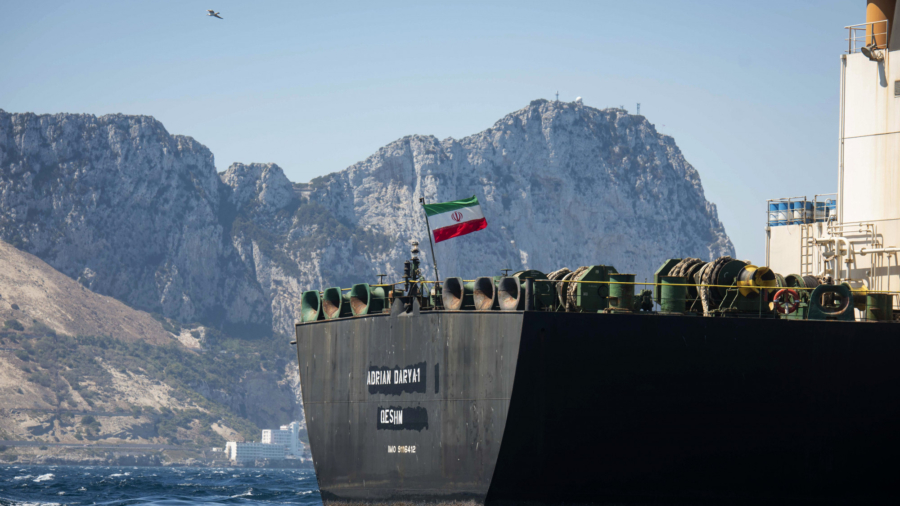An Iranian oil tanker blacklisted and pursued by the U.S. turned off its tracking beacon off the coast of Syria, leading to renewed speculation on Tuesday, Sept. 3, that its oil will end up there, despite earlier assurances, it wouldn’t.
The disappearance of the Adrian Darya 1, formerly known as the Grace 1, follows a pattern of Iranian oil tankers turning off their Automatic Identification System (AIS) to try and mask where they deliver their cargo amid U.S. sanctions targeting Iran’s energy industry.
Its disappearance comes after the British territory of Gibraltar seized the tanker and ultimately released it weeks later when officials there said they received assurances its oil wouldn’t go to Syria, underscoring the challenges authorities face as a U.S. maximum pressure campaign against Iran continues.
President Donald Trump’s withdrawal from the 2015 nuclear deal between Iran and Western powers and the imposition of substantial economic sanctions on Iran have blocked it from selling its crude oil abroad, a crucial source of government funding for Iran.
Meanwhile, tensions have spiked across the Persian Gulf over mysterious tanker explosions, the shooting down of a U.S. military surveillance drone by Iran and America deploying more troops and warplanes to the region.
The Adrian Darya 1, which carries 2.1 million barrels of Iranian crude worth some $130 million, switched off its AIS beacon just before 1600 GMT Monday, according to the ship-tracking website MarineTraffic.com. The ship was some 45 nautical miles (approximately 52 miles) off the coast of Lebanon and Syria, heading north at its last report.

Earlier, Secretary of State Mike Pompeo had said the United States had intelligence that the Adrian Darya 1 would head to the Syrian port of Tartus, just a short distance from its last reported position.
The actions of the Adrian Darya 1 follow a pattern of other Iranian ships turning off their trackers once they reach near Cyprus in the Mediterranean Sea, said Ranjith Raja, a lead analyst at the data firm Refinitiv.
Based on the fact Turkey has stopped taking Iranian crude oil and Syria historically has taken around 1 million barrels of crude oil a month from Iran, Raja said it was likely that the ship would be offloading its cargo in Syria. That could see it transfer crude oil onto smaller vessels, allowing it to be taken to port, he said.
“The Iranian oil going to Syria is not something new,” Raja said. “This is a known fact.”
The oil shipment website “Tanker Trackers” similarly believes the Adrian Darya 1 to be off Syria. “It is now safe to assume she is in Syria’s territorial waters,” Tanker Trackers wrote on Twitter on Tuesday.
Iranian officials haven’t identified who bought the ship’s cargo, only that it has been sold.
The United States has sought to seize the tanker, alleging in federal court that the ship is owned by Iran’s Revolutionary Guard, a paramilitary organization answerable only to Supreme Leader Ayatollah Ali Khamenei. The United States recently declared the Guard a terrorist organization, giving it greater powers to pursue seizing its assets.
U.S. officials since have warned countries not to aid the Adrian Darya 1, which previously said it would be heading to Greece and Turkey before turning off its tracker on Monday.
Authorities in Gibraltar alleged the ship was bound for a refinery in Baniyas, Syria when they seized it in early July on suspicion of violating E.U. sanctions.

Under the landmark 2015 agreement, Iran agreed to limit its enrichment of uranium in exchange for the lifting of economic sanctions. The International Atomic Energy Agency confirmed last week that Iran’s stockpile of low-enriched uranium still exceeds the amount allowed by the deal. The U.N. agency also said Iran continues to enrich uranium up to 4.5 percent, above the 3.67 percent permitted under the agreement but still far below weapons-grade levels of 90 percent.
Iran has warned it will take additional steps away from the accord on Friday if it doesn’t get help from Europe to sell its oil abroad, calling it their “third step” away from the deal.
An Iranian lawmaker has suggested France is proposing a $15 billion credit line for Tehran if it returns to the deal. However, the top diplomat of French President Emmanuel Macron, who is leading talks seeking relief for Iran and de-escalation of tensions in the region, said Tuesday that the figure is Iran’s—not proposed by the French.
The official said Iran’s decision to take new measures Friday without a deal does not mean there can be no future arrangements.
“One mustn’t create artificial deadlines to measure the success of what we’re doing,” he said. He could not be identified publicly because of the sensitive nature of the subject.
“Obviously, if the Iranians do Friday what they said, it will make the work more complicated,” he added.
Iran Deputy Foreign Minister Abbas Araghchi echoed that threat during a visit to Slovenia on Tuesday, lashing out at both Trump for pulling out of the nuclear deal and at Europeans for failing to implement a solution that would compensate for the United States’ withdrawal.
“They promised to find practical solutions in order to let Iran still benefit from the sanctions lifting to compensate the absence of the U.S.,” Araghchi said. “What happened? … The Europeans are still not able to create a simple banking channel to let business between Iran and Europe, to let their own companies do business with Iran.”


